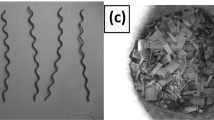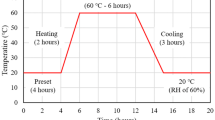Abstract
Steel fiber addition in concrete is widely known to increase the non-flexural performance of concrete structures such as shear capacity. Design guides such as fib Model Code (2010) have recognised this effect and that these guidelines may become widely accepted. The current design guides are based on laboratory scale tests which may be compromised by the scale effects. This paper reports the results of full sized precast prestressed bridge beams that were fabricated and tested to shear failure. Two beams had steel fiber and two beams were plain concrete. None of the beams had any vertical shear reinforcements. The addition of steel fiber at the dosage of 60 kg per cubic metre resulted in more than twice the shear capacity as compared to the beams without steel fibers. The results of the fiber reinforced beams were compared with the calculated shear capacity of the fib Model Code (2010) and plastic design method. This paper presents a method to include prestress in previously developed plastic design method. The model code method predicted an increase of shear capacity of 22 % as compared to the experimental results of 112 % increase due to steel fiber addition. This demonstrates that the model code is not effective in taking into consideration of the contributions by steel fibers. The plastic design approach predicted an increase of shear capacity of 122 % which is close to the experimental values. Based on this full scale tests, the plastic design approach appears to be more suitable for estimation of shear capacity enhancement when steel fibers are used.











Similar content being viewed by others
References
Parra-Montesinos GJ (2006) Shear strength of beams with deformed steel fibers. Concr Int 28(11):57–66
Aoude H, Belghiti M, Cook WD, Mitchell D (2012) Response of steel fiber-reinforced concrete beams with and without stirrups. ACI Struct J 109(3):359–367
Minelli F (2005) Plain and fiber reinforced concrete beams under shear loading: structural behaviour and design applications. PhD thesis, Department of Civil Engineering, University of Brescia, Starrylink Editrice, Brescia
Minelli F, Plizzari GA (2006) Steel fibers as shear reinforcement for beams. In: Proceedings of the second International fib congress, Naples
Foster S (2010) Design of FRC beams for shear using the VEM and the draft Model Code approach. In: fib Bulletin 57: Shear and punching shear in RC and FRC elements, pp 195–210
Meda A, Minelli F, Plizzari GA, Riva P (2005) Shear behaviour of steel fibre reinforced concrete beams. Mater Struct 38:343–351
Gustafsson J, Noghabai K (1999) Steel fibers as shear reinforcement in high strength concrete beams. Luleå University of Technology, Luleå
Spinella N (2013) Shear strength of full-scale steel fibre-reinforced concrete beams without stirrups. Comput Concr 11(5):365–382
Ng TS (2011) An investigation into the development of high performance geopolymer concrete. PhD Thesis, University of New South Wales
Minelli F, Giovanni AP (2010) Shear strength of FRC members with little or no shear reinforcement: a new analytical model In: fib Bulletin 57: Shear and punching shear in RC and FRC elements, pp 211–225
fib Model Code 2010—Final draft, Volumes 1 and 2, available as fib Bulletins 65 and 66
Kragh-Poulsen J, Hoang LC, Goltermann P (2011) Shear capacity of steel and polymer fiber reinforced concrete beams. Mater Struct 44(6):1079–1091
Zhang JP (1997) Diagonal cracking and shear strength of reinforced concrete beams. Mag Concr Res 49(178):55–65
Nielsen MP, Hoang LC (2011) Limit analysis and concrete plasticity, 3rd edn. CRC Press, Boca Raton, ISBN 978-1-4398-0396-7
MoreillonL, Nseir J, Suter R, Le Roy R (2012) Shear strength of pre-tensioned members in high strength fibre reinforced concrete. In: 8th RILEM international symposium on fibre reinforced concrete
Acknowledgments
The authors are grateful to Professors Linh Hoang and M.P. Nielsen from the Technical University of Denmark for hosting the first author of this paper as a visitor and the valuable discussions and clarifying the issues on Plastic Design approach. The authors are also grateful to Professor Stephen Foster for the discussions and introduction to the Variable Engagement Model.
Author information
Authors and Affiliations
Corresponding author
Rights and permissions
About this article
Cite this article
Bendtsen, B., Sanjayan, J.G. Assessment of shear capacity methods of steel fiber reinforced concrete beams using full scale prestressed bridge beams. Mater Struct 48, 3473–3483 (2015). https://doi.org/10.1617/s11527-014-0415-3
Received:
Accepted:
Published:
Issue Date:
DOI: https://doi.org/10.1617/s11527-014-0415-3




